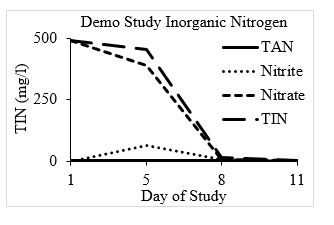LOW-COST DENITRIFICATION IN BRACKISH WATER AQUACULTURE PRODUCTION
Nitrate accumulation is a primary limiting factor of water reuse in many recirculating aquaculture systems (RAS). Water reuse is critical in inland marine RAS, as expensive artificial sea salts are often used to create salt water. Denitrification, a process in which facilitative anaerobic microbes reduce nitrate to dinitrogen gas, may allow producers to reuse water for extended periods of time. This may result in significant cost savings for producers and may have positive environmental impacts by reducing wastewater discharge. This presentation will cover several past and ongoing trials investigating simple, low-cost denitrification methods in brackish water aquaculture systems.
Three studies and a demonstration project were conducted to examine different denitrification strategies. The first study examined the effectiveness of simple, external denitrification chambers containing different media types. The treatments included plastic bio-media (BM), expanded clay pellets (EC), woodchips (WC), and a control (CO) using no media. A second study examined the addition of ethanol at a 2:1 carbon: nitrogen ratio to 4 different treatments filled with water from an active shrimp production system. The treatments were aerated with ethanol, aerated with no ethanol, no aeration with ethanol, and no aeration with no ethanol (AWE, ANE, NAWE, and NANE). The third project examined denitrification in used aquaculture water using different carbon: nitrogen ratios (1:1, 3:1, 5:1, 0:1) created through ethanol additions in systems with no aeration. The demonstration project tested a denitrification method using ethanol at an active shrimp farm in a 17 m3 shrimp tank.
The first study showed that all media types and the control (no media) can denitrify to some extent, which led to further investigations using low oxygen/low ORP environments in bodies of water without an external denitrification chamber. The second study showed a significant amount of partial denitrification in the NAWE treatment, but this treatment also had a large amount of nitrite accumulation, indicating insufficient carbon or insufficient time. The third study showed over a 95% reduction of nitrate in the 1:1 and 3:1 treatments over the course of 27 days. The demonstration study showed a significantly faster rate of denitrification, likely due to temperature. Nitrate fell from 495 mg/l to 2.9 mg/l in 11 days and only required 35 L of ethanol to denitrify 17 m3 of water. This has important implications for shrimp producers, as a rapid and low-cost denitrification method may significantly increase the longevity of water reuse and greatly reduce water discharge and salt use.
